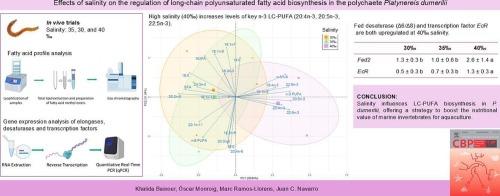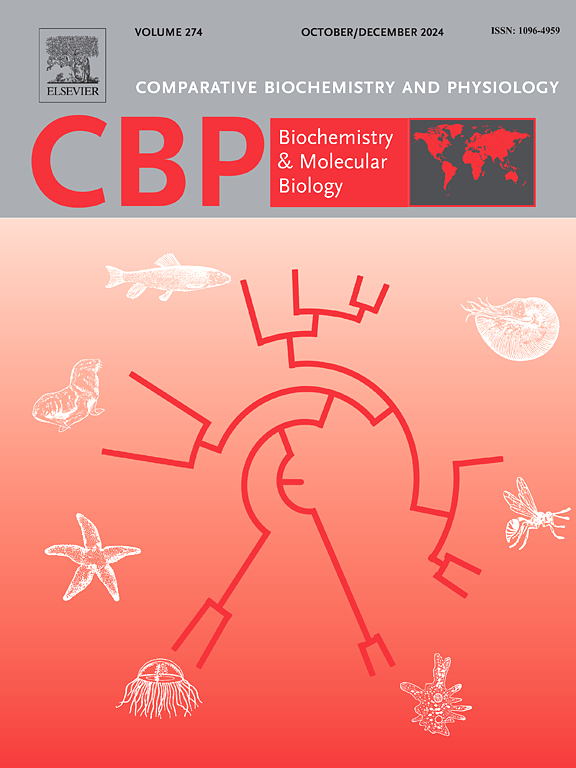盐度对多毛藻长链多不饱和脂肪酸生物合成调控的影响。
IF 1.8
3区 生物学
Q4 BIOCHEMISTRY & MOLECULAR BIOLOGY
Comparative Biochemistry and Physiology B-Biochemistry & Molecular Biology
Pub Date : 2025-09-12
DOI:10.1016/j.cbpb.2025.111164
引用次数: 0
摘要
多毛动物是n-3长链(≥C20)多不饱和脂肪酸(LC-PUFA)的有希望的来源,因为它们能够通过延长酶、前端去饱和酶(Fed)和甲基端去饱和酶合成这些必需的营养物质。盐度可以通过触发改变膜脂组成的渗透应激来影响水生无脊椎动物的脂质代谢。本研究探讨了盐度对进化与发育生物学模式生物——多毛藻(Platynereis dumerilii)中LC-PUFA生物合成的影响。在标准条件下(18 °C, 16 L:8D光周期,冷冻菠菜为饲料)对幼鱼进行体内试验,评估三种盐度水平:30 ‰,35 ‰和40 ‰。1个月后,评估存活和生长情况,并收集样本,通过分析总脂质、脂肪酸(FA)谱以及延长酶、去饱和酶和转录因子(TF)的基因表达来评估n-3 LC-PUFA生物合成的调节。尽管饮食均匀,盐度为40 ‰时,P. dumerilii的n-3 LC-PUFA水平升高(20:4n- 3,20:5 n- 3,22:5 n-3)。FA谱的变化表明盐度在脂质代谢中起调节作用。基因表达分析显示,在高盐度(40 ‰)条件下,Fed活性显著上调(Δ6/Δ8),与其底物二十碳二烯酸(20:2n-6)和二十碳三烯酸(20:3n-3)水平降低一致。此外,TF EcR(蜕皮激素受体)表达增加,提示参与LC-PUFA生物合成调控。这些结果表明,在高盐度条件下培养杜氏假凤尾藻可以提高其n-3 LC-PUFA含量。同样,被认为是水产养殖饲料可持续替代品的其他多毛类的营养价值也可以通过盐度调节得到改善。本文章由计算机程序翻译,如有差异,请以英文原文为准。

Effects of salinity on the regulation of long-chain polyunsaturated fatty acid biosynthesis in the polychaete Platynereis dumerilii
Polychaetes are promising sources of n-3 long-chain (≥C20) polyunsaturated fatty acid (LC-PUFA) due to their ability to synthesise these essential nutrients through elongases, front-end desaturases (Fed), and methyl-end desaturases. Salinity can influence lipid metabolism in aquatic invertebrates by triggering osmotic stress that alters membrane lipid composition. This study investigates the effect of salinity on LC-PUFA biosynthesis in the polychaete, Platynereis dumerilii, a model organism in Evolutionary and Developmental Biology. In vivo trials were conducted with juveniles under standard conditions (18 °C, 16 L:8D photoperiod, frozen spinach as feed), evaluating three salinity levels: 30 ‰, 35 ‰, and 40 ‰. After one month, survival and growth were assessed, and samples were collected to evaluate the modulation of n-3 LC-PUFA biosynthesis by analysing total lipids, fatty acid (FA) profiles, and gene expression of elongases, desaturases, and transcription factors (TF). Despite a uniform diet, P. dumerilii at 40 ‰ salinity exhibited elevated levels of n-3 LC-PUFA (20:4n-3, 20:5n-3, 22:5n-3). Variations in FA profiles suggest salinity plays a regulatory role in lipid metabolism. Gene expression analysis showed significant upregulation of a Fed, with Δ6/Δ8 activity, under high salinity (40 ‰), consistent with reduced levels of its substrates, eicosadienoic acid (20:2n-6) and eicosatrienoic acid (20:3n-3). Additionally, the TF EcR (Ecdysone receptor) showed increased expression, suggesting involvement in LC-PUFA biosynthesis regulation. These findings indicate that cultivating P. dumerilii in high salinity may enhance its n-3 LC-PUFA content. Similarly, the nutritional value of other polychaetes, considered sustainable alternatives for aquaculture feed, may be improved through salinity modulation.
求助全文
通过发布文献求助,成功后即可免费获取论文全文。
去求助
来源期刊
CiteScore
4.60
自引率
4.50%
发文量
77
审稿时长
22 days
期刊介绍:
Comparative Biochemistry & Physiology (CBP) publishes papers in comparative, environmental and evolutionary physiology.
Part B: Biochemical and Molecular Biology (CBPB), focuses on biochemical physiology, primarily bioenergetics/energy metabolism, cell biology, cellular stress responses, enzymology, intermediary metabolism, macromolecular structure and function, gene regulation, evolutionary genetics. Most studies focus on biochemical or molecular analyses that have clear ramifications for physiological processes.

 求助内容:
求助内容: 应助结果提醒方式:
应助结果提醒方式:


